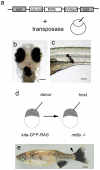Kita driven expression of oncogenic HRAS leads to early onset and highly penetrant melanoma in zebrafish
- PMID: 21170325
- PMCID: PMC3000817
- DOI: 10.1371/journal.pone.0015170
Kita driven expression of oncogenic HRAS leads to early onset and highly penetrant melanoma in zebrafish
Abstract
Background: Melanoma is the most aggressive and lethal form of skin cancer. Because of the increasing incidence and high lethality of melanoma, animal models for continuously observing melanoma formation and progression as well as for testing pharmacological agents are needed.
Methodology and principal findings: Using the combinatorial Gal4-UAS system, we have developed a zebrafish transgenic line that expresses oncogenic HRAS under the kita promoter. Already at 3 days transgenic kita-GFP-RAS larvae show a hyper-pigmentation phenotype as earliest evidence of abnormal melanocyte growth. By 2-4 weeks, masses of transformed melanocytes form in the tail stalk of the majority of kita-GFP-RAS transgenic fish. The adult tumors evident between 1-3 months of age faithfully reproduce the immunological, histological and molecular phenotypes of human melanoma, but on a condensed time-line. Furthermore, they show transplantability, dependence on mitfa expression and do not require additional mutations in tumor suppressors. In contrast to kita expressing melanocyte progenitors that efficiently develop melanoma, mitfa expressing progenitors in a second Gal4-driver line were 4 times less efficient in developing melanoma during the three months observation period.
Conclusions and significance: This indicates that zebrafish kita promoter is a powerful tool for driving oncogene expression in the right cells and at the right level to induce early onset melanoma in the presence of tumor suppressors. Thus our zebrafish model provides a link between kita expressing melanocyte progenitors and melanoma and offers the advantage of a larval phenotype suitable for large scale drug and genetic modifier screens.
Conflict of interest statement
Figures







References
-
- Gaggioli C, Sahai E. Melanoma invasion - current knowledge and future directions. Pigment Cell Res. 2007;20:161–172. - PubMed
-
- Bevona C, Goggins W, Quinn T, Fullerton J, Tsao H. Cutaneous melanomas associated with nevi. Arch Dermatol. 2003;139:1620–1624; discussion 1624. - PubMed
-
- Larue L, Beermann F. Cutaneous melanoma in genetically modified animals. Pigment Cell Res. 2007;20:485–497. - PubMed
-
- Stern HM, Zon LI. Cancer genetics and drug discovery in the zebrafish. Nat Rev Cancer. 2003;3:533–539. - PubMed
Publication types
MeSH terms
Substances
Grants and funding
LinkOut - more resources
Full Text Sources
Medical
Molecular Biology Databases
Research Materials
Miscellaneous

